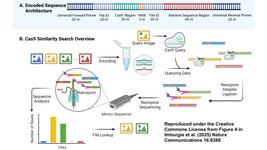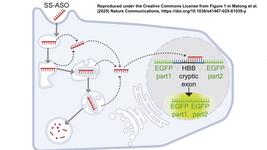CMN Weekly (28 April 2023) - Your Weekly CRISPR Medicine News
By: Gorm Palmgren - Apr. 28, 2023
Top picks
- University of Florida researchers have developed a promising new CRISPR-powered method for noninvasive blood tests that could help clinicians diagnose cancer at earlier stages. The one-pot isothermal Cas12-based assay allows for the sensitive and accurate detection of specific microRNAs. In addition, it is compatible with smartphone-based fluorescence detection and lateral-flow format for visual readouts.
- German researchers present a simultaneous knock-in and base editing method that prevents translocations in multiplex-edited CAR T cells. The technique combines Cas9 nuclease and base editing within a single intervention that can achieve both knock-in of a chimeric antigen receptor (CAR) into the T cell receptor alpha constant (TRAC) gene and two knock-outs that silence expression of major histocompatibility complexes (MHC) class I and II.
Research
- Researchers at the University of California Berkeley have developed a peptide-mediated delivery system of CRISPR enzymes to edit primary human lymphocytes efficiently. The method is minimally perturbative, does not require dedicated hardware, and is compatible with multiplexed editing via sequential delivery, minimising the risk of genotoxicity. In addition, a new compact RNA base editor has been developed by fusing an adenosine deaminase acting on RNA (ADAR) with an engineered Cas6e. Comprising only 199 amino acids, Cas6e is suitable for AAV delivery, and the complex allowed for an efficiency of 68% on the Duchenne muscular dystrophy (DMD) Q1392X mutation.
- American researchers have discovered that Csx28 - an accessory protein found in some CRISPR-Cas systems - enhances antiphage defence by CRISPR-Cas13b. Upon Cas13 activation by viral messenger RNAs, Csx28 forms a membrane pore that slows cellular metabolism and thus increases antiviral defence.
- Researchers in China have developed a CRISPR-based dual-function A-to-G and C-to-G base editor (GGBE), capable of converting simultaneous A and C to G conversion with substantial editing efficiency. The GGBE was formed by fusing the chromosomal protein HMGN1, GBE and ABE to Cas9.
Industry
- Editas Medicine has received an FDA orphan drug designation for EDIT-301, an investigational, gene-editing medicine for treating sickle cell disease (SCD). EDIT-301 confers a sustained increase in fetal haemoglobin production, which has the potential to provide a one-time, durable treatment benefit for people living with severe SCD.
- FDA’s Center for Biologics Evaluation and Research (CBER) will launch Operation Warp Speed, which aims to have cell and gene therapies for rare diseases ready for the market as quickly as possible. The program will learn from a previous program with the same name that worked so well to accelerate the development of COVID-19 vaccines.
Detection
- CRISPR gel is a novel one-pot biosensing platform for rapidly and sensitively detecting HIV viral RNA. The method uses a CRISPR gel biosensing platform, with Cas12a enzymes embedded into an agarose gel and reverse transcription-recombinase polymerase amplification (RT-RPA). The assay successfully detected down to 30 copies of HIV RNA per test within 30 min.
- The discovery of two novel Cas12 enzymes (SLK-9 and SLK5-2) with enzymatic activity at 60°C has led to a new detection method for SARS-CoV-2. The new method utilises loop-mediated isothermal amplification and enables real-time, single-step nucleic acid detection with sensitivity down to 5 copies/μL and a time to result of under 30 minutes.
- Researchers in China have developed a Cas12a-based methylation-sensitive transcription-enhanced single-molecule biosensor to detect DNA methylation in human cells and tissues. The biosensor employs a rationally designed transcription machine to produce ssRNA transcripts that activate Cas12a and lead to a fluorophore signal.
- Chinese researchers present an ultrasensitive and specific biosensor for miRNA detection. The dual-amplified biosensing method uses CRISPR-Cas13a to trigger Cas12a and produce a strong fluorescent signal. The detection limit of the so-called Cas13a-12a amplification method using synthetic miRNA-155 was as low as 0.35 fM.
Reviews
- How has CRISPR transformed therapeutic drug discovery? This review explores the importance of CRISPR in developing breakthrough therapies for monogenic conditions and neurodegenerative diseases and enhancing the effectiveness of immuno-oncology.
- Homology-Directed-Repair-Based Genome Editing in HSPCs for the Treatment of Inborn Errors of Immunity and Blood Disorders. This review highlights the transformational benefits of HDR-mediated gene therapy and possible solutions for the existing problems holding the methodology back. Moreover, it aims to help bring HDR-based gene therapy in CD34+ hematopoietic stem progenitor cells (HSPCs) from the lab bench to the bedside.
- Unintended CRISPR-Cas9 editing outcomes: a review of the detection and prevalence of structural variants generated by gene-editing in human cells. This review looks at larger structural variants (SVs) and chromosomal abnormalities associated with CRISPR-editing in cells of human origin and highlights the methods used to detect and avoid them.
- Increasing Specificity of Targeted DNA Methylation Editing by Non-Enzymatic CRISPR/dCas9-Based Steric Hindrance. This review notes some of the shortcomings of epigenetic editing technology - specifically the risks involved in introducing epigenetic enzymes - and highlights an alternative epigenetic editing strategy using physical occlusion to modify epigenetic marks at target sites without a requirement for any epigenetic enzyme.
- Applications of Anti-CRISPR Proteins in Genome Editing and Biotechnology. This review highlights the abilities of anti-CRISPR (Acr) proteins to modulate the activities and properties of CRISPR-Cas effectors. It also covers how Acr's have been developed to overcome bacterial immunity, facilitate viral vector production, control synthetic gene circuits, and other purposes.
News from CRISPR Medicine News
- On Monday, we interviewed the inventors of CRISPR-Select - a fast and easy way to determine any genetic sequence variant's pathogenicity and drug responsiveness. The method stands out by treating experimental and control cells in the same pot, leading to conclusive and bias-free results, and it can be used to validate drug targets and patient groups.
To get more of the CRISPR Medicine News delivered to your inbox, sign up to the free weekly CMN Newsletter here.
Tags
CLINICAL TRIALS
IND Enabling
Phase I
Phase II
Phase III
Recurrent or Progressive High-grade Glioma, (NCT06737146)
Sponsors:
Suzhou Maximum Bio-tech Co., Ltd.
Sponsors:
Suzhou Maximum Bio-tech Co., Ltd.
IND Enabling
Phase I
Phase II
Phase III
Advanced Peritoneal Malignancies or Abdominal Metastatic Solid Tumors, (NCT06912152)
Sponsors:
Zhejiang University
Sponsors:
Zhejiang University
IND Enabling
Phase I
Phase II
Phase III







